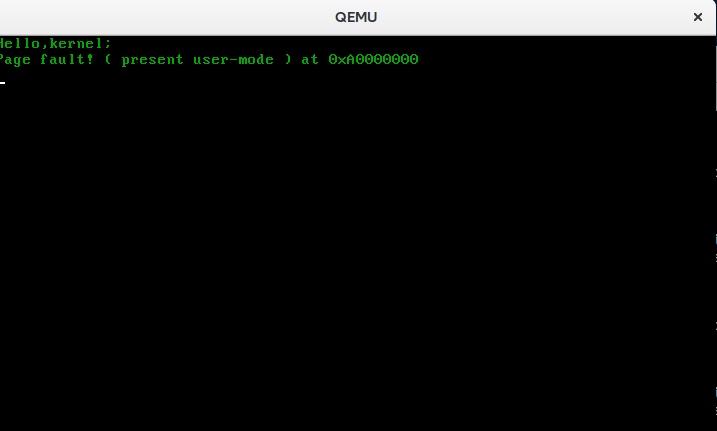我老早就理解了分页的原理,不过真正落实到具体代码的时候,仍然花了好大一番功夫。我发现试图从代码中理解思路是非常困难的。因为正常的流程是先有思路,后有代码,假如一个完全不理解分页的人,试图通过阅读代码学会它,这几乎是找罪受。
即使我理解了分页,在我学习James的这篇[Paging ]教程时,仍然花了好大的劲,最后不得不逼我用出GDB + IDA进行调试,这才搞懂了它的代码思路。
这篇文章是我个人的笔记,所以不会去从头讲原理,只讲解实现分页代码的主要部分,想学原理可以看James的教程。
内存管理 placement_address 指向 SECTIONS 的最后,也就是bss段的后面,该位置属于未分配的内存。
1 2 3 4 5 6 7 8 9 10 11 12 13 14 15 16 u32 alloc_address_int (u32 size ,int align,u32 *phys) { if (align == 1 && (placement_address & 0xFFFFF000 )){ placement_address &= 0xFFFFF000 ; placement_address += 0x1000 ; } if (phys){ *phys = placement_address; } u32 tmp = placement_address; placement_address += size ; return tmp; }
页表和页目录 page 就是页目录项和页表项的结构,其中涉及到各种位,我保留了英文的注释,想具体了解也可看文档。
代码里需要说明的位置我加上了中文注释。
1 2 3 4 5 6 7 8 9 10 11 12 13 14 15 16 17 18 19 20 21 22 23 24 25 26 27 28 29 30 31 32 33 34 35 36 typedef struct page { u32 present : 1 ; u32 rw : 1 ; u32 user : 1 ; u32 accessed : 1 ; u32 dirty : 1 ; u32 unused : 7 ; u32 frame : 20 ; } page_t ; typedef struct page_table { page_t pages[1024 ]; } page_table_t ; typedef struct page_directory { page_table_t *tables[1024 ]; u32 tablesPhysical[1024 ]; u32 physicalAddr; } page_directory_t ;
Frame分配 页帧的分配,采用了一种数据结构叫bitset,就是用一连串的bit位,比如01011110,每一个位对应一个页帧,如果是1表示该页帧已被分配,如果是0表示未分配。bit串的第1位,对应物理地址0x0000,第2位对应0x1000,以此类推。
下面只贴出主要代码:
1 2 3 4 5 6 7 8 9 10 11 12 13 14 15 16 17 18 19 20 21 22 23 24 25 26 27 28 29 30 31 32 33 34 35 36 37 38 39 40 41 42 43 44 45 46 47 48 static void set_frame (u32 frame_addr) u32 frame = frame_addr / 0x1000 ; u32 idx = INDEX_FROM_BIT(frame); u32 off = OFFSET_FROM_BIT(frame); frames[idx] |= (0x1 << off); } ······ static u32 first_frame () u32 i, j; for (i=0 ; i < INDEX_FROM_BIT(nframes);i++){ if (frames[i] != 0xFFFFFFFF ){ for (j = 0 ; j < 32 ; j++) { u32 toTest = 0x1 << j; if ( !(frames[i]&toTest)){ return i *4 *8 +j; } } } } } void alloc_frame (page_t *page, int is_kernel, int is_writeable) if (page->frame != 0 ) { return ; } else { u32 idx = first_frame(); if (idx == (u32)-1 ) { printk("No free frames!" ) return ; } set_frame(idx*0x1000 ); page->present = 1 ; page->rw = (is_writeable)?1 :0 ; page->user = (is_kernel)?0 :1 ; page->frame = idx; } }
set_frame 表示将指向的bit位置1。
初始化分页 初始化函数,展示了开启分页从头到尾的流程。
1 2 3 4 5 6 7 8 9 10 11 12 13 14 15 16 17 18 19 20 21 22 23 24 25 26 27 28 29 30 31 32 33 34 35 void initialise_paging () u32 mem_end_page = 0x1000000 ; nframes = mem_end_page / 0x1000 ; frames = (u32*)alloc_address(INDEX_FROM_BIT(nframes)); memset (frames,0 ,INDEX_FROM_BIT(nframes)); kernel_directory = (page_directory_t *)alloc_address_a(sizeof (page_directory_t )); memset (kernel_directory, 0 , sizeof (page_directory_t )); current_directory = kernel_directory; int i = 0 ; while (i < placement_address){ alloc_frame(get_page(i,1 ,kernel_directory),0 ,0 ); i += 0x1000 ; } register_interrupt_handler(14 ,page_fault); switch_page_directory(kernel_directory); }
最后一个比较重要的函数get_page,它用来分配一个页表,并将这个页表的指针写进页目录项。
1 2 3 4 5 6 7 8 9 10 11 12 13 14 15 16 17 18 19 20 21 22 23 24 25 26 27 28 29 page_t *get_page (u32 address, int make, page_directory_t *dir) address /= 0x1000 ; u32 table_idx = address / 1024 ; if (dir->tables[table_idx]) { return &dir->tables[table_idx]->pages[address%1024 ]; } else if (make) { u32 tmp; dir->tables[table_idx] = (page_table_t *)alloc_address_ap(sizeof (page_table_t ), &tmp); memset (dir->tables[table_idx], 0 , 1024 *4 ); dir->tablesPhysical[table_idx] = tmp | 0x7 ; return &dir->tables[table_idx]->pages[address%1024 ]; } else { return 0 ; } }
测试 最后检验一下,功能的可靠性,我们先初始化并开启分页机制,然后尝试访问未分配的虚拟地址0xA0000000,造成页故障。
1 2 3 4 5 6 7 8 9 10 11 12 13 14 15 16 17 18 19 20 21 22 int kmain (void ) console_clear(); init_gdt(); init_idt(); printk("Hello,kernel;\n" ); init_timer(200 ); initialise_paging(); u32 *ptr = (u32*)0xA0000000 ; u32 do_page_fault = *ptr; return 0 ; }
成功触发页故障,并调用了我们写好的page_fault函数。
参考资料:JamesM’s kernel development tutorials
